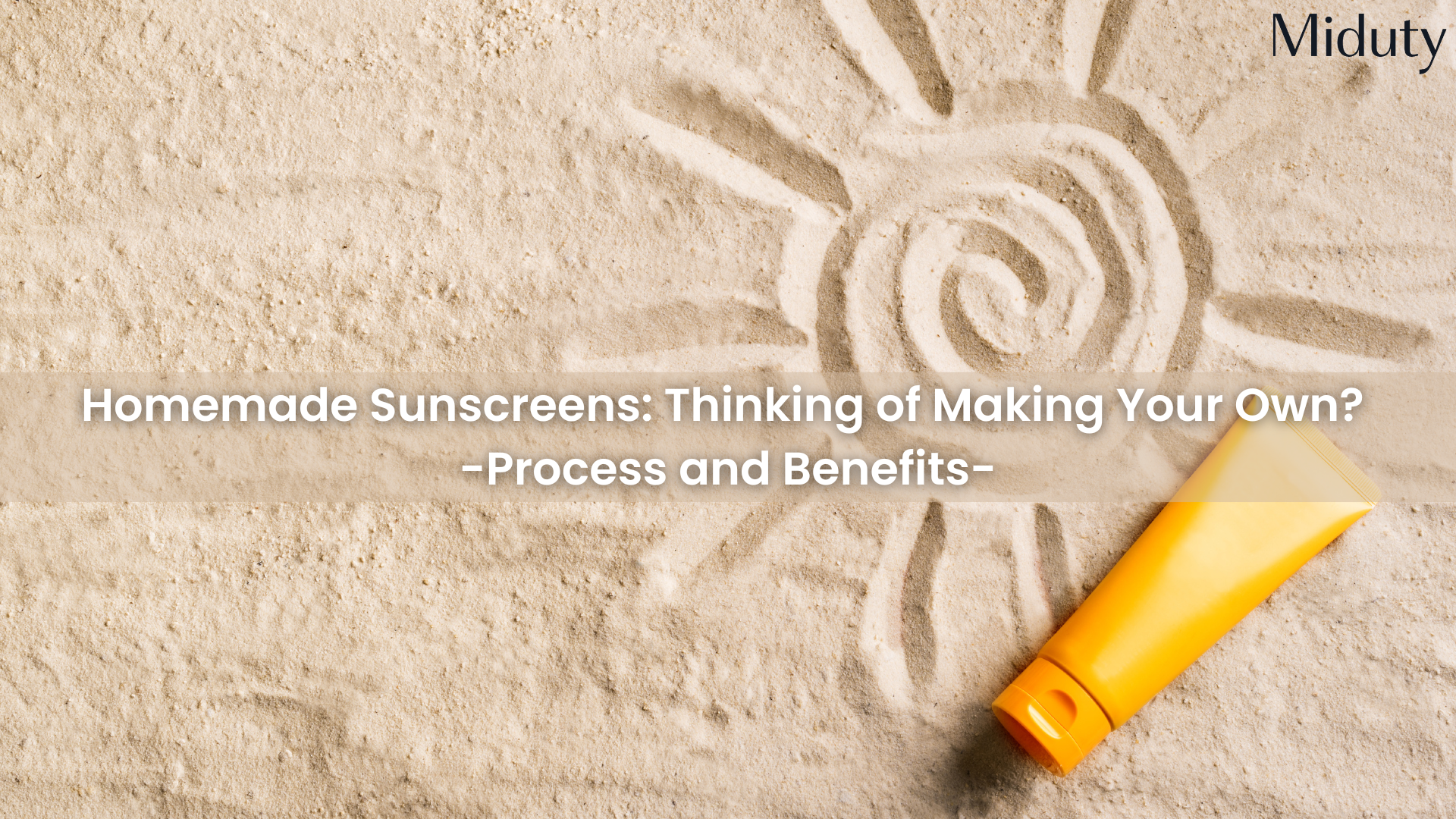
Homemade Sunscreens: Thinking of Making Your Own? | Process and Benefits
Introduction | Concern about Sunscreen | Homemade Sunscreen | How to make? | Benefits | Drawbacks| Homemade sunscreens vs. Ordinary Sunscreens | Application at Home | Safety Tips | Conclusion | FAQs | References
Key Takeaways:
- While homemade sunscreens often use natural ingredients like zinc oxide, coconut oil, and essential oils, their SPF levels can be inconsistent and unreliable.
- Making sunscreen at home can be appealing due to the control over ingredients and the use of more natural, chemical-free options.
- When comparing homemade and commercial sunscreens for daily use, the main difference lies in reliability and effectiveness.
- Although the risk of sun exposure indoors is lower, UVA rays can penetrate windows and cause skin damage over time, particularly if you're near windows with direct sunlight.

Introduction
Sunscreen has become a hot topic of conversation in the world of skincare. From beauty experts to dermatologists, everyone is talking about its importance-and for good reason. As awareness of the damaging effects of UV rays increases, people are becoming more conscious of the need to incorporate sunscreen into their daily routines.
Today, many individuals are growing more concerned about the ingredients in their skincare products, including sunscreen. The long-term impact of certain chemicals found in traditional sunscreens, such as oxybenzone and octinoxate, has raised questions about safety-not just for people but also for the environment.
This has led to a surge in demand for more natural, eco-friendly alternatives, and homemade sunscreens have emerged as a popular option.
Why Are People So Concerned About Sunscreen?
The primary concern revolves around the chemicals used in conventional sunscreens. Ingredients like oxybenzone have been linked to potential health risks, as well as environmental harm, particularly in marine ecosystems. As a result, people are increasingly seeking natural solutions that align with both their health goals and their desire to protect the planet.
This growing shift toward clean beauty has many asking, "Should sunscreen be made at home?" Natural skincare enthusiasts often tout homemade sunscreens as a safer alternative. However, it's important to understand the benefits and limitations of these DIY options before deciding if they truly provide adequate protection.
Let's get started!
What is Homemade Sunscreen?
Homemade sunscreen is exactly what it sounds like-sunscreen that you make yourself using natural ingredients. Unlike store-bought sunscreens, which often contain a mix of chemicals to block or absorb UV rays, DIY sunscreens rely on naturally occurring substances like zinc oxide, shea butter, and oils that are believed to have protective properties.
Many proponents of homemade sunscreen praise it for being chemical-free, eco-friendly, and gentle on sensitive skin. However, its efficacy in protecting against harmful UV rays is a topic of debate. [1]
How to Make Sunscreen at Home: The Basics

If you're interested in how to make sunscreen at home, the process is relatively simple but requires a few specific ingredients. The key ingredient in most homemade sunscreens is non-nano zinc oxide, which acts as a physical barrier that blocks UV rays.
Basic Homemade Sunscreen Recipe:
Ingredients:
- ½ cup coconut oil (natural moisturizer)
- ¼ cup shea butter (for smooth texture)
- 2 tbsp non-nano zinc oxide (SPF protection)[2]
- ¼ cup pure aloe vera gel (optional, for water resistance)
- A few drops of walnut extract oil (for scent)
Instructions:
- Melt the coconut oil, shea butter, and beeswax in a double boiler until combined.
- Remove from heat and let the mixture cool slightly.
- Add non-nano zinc oxide and essential oils, and mix thoroughly.
- Pour into a container and allow it to cool until it hardens into a cream.
This simple recipe is often used by people looking for a natural alternative to ordinary sunscreen. But there's a catch-homemade sunscreen's effectiveness depends heavily on the quantity of zinc oxide and how well it's applied.
Benefits of Homemade Sunscreens
1. Control Over Ingredients
One of the main benefits of making sunscreen at home is knowing exactly what's going on in your product. Many conventional sunscreens contain synthetic chemicals like oxybenzone and octinoxate, which some studies suggest could be harmful to marine ecosystems and even human health. [3]
2. Suitable for Sensitive Skin

Store-bought sunscreens may cause irritation or allergic reactions in people with sensitive skin. Homemade sunscreens typically contain natural ingredients that are gentler and free from harsh chemicals.
3. Customization
You can adjust your homemade sunscreen's consistency, scent, and texture according to your preferences. Want a thicker, more moisturizing cream? Add more shea butter. Prefer a lightweight lotion? Use less beeswax.
Drawbacks of Homemade Sunscreens
While homemade sunscreens offer natural alternatives, there are some significant downsides to consider.[4]
1. Uncertain SPF Levels
The most concerning aspect of homemade sunscreens is the uncertainty around SPF (Sun Protection Factor). There's no reliable way to measure how well your homemade product blocks UVA and UVB rays. Without precise testing, it's difficult to guarantee effective sun protection.
2. Inconsistent Application

Homemade sunscreens may not spread as evenly as their store-bought counterparts, which can lead to patchy coverage and increase the risk of sunburn. Without proper application, your skin could still be exposed to harmful UV rays.
3. Shorter Shelf Life
Since homemade sunscreens lack preservatives, their shelf life is much shorter. Oils and other natural ingredients can go rancid, reducing the effectiveness of your sunscreen over time. [5]
How Does Homemade Sunscreen Compare to Ordinary Sunscreen?

When considering homemade sunscreen versus ordinary sunscreen, it's important to evaluate them across several factors, such as protection, convenience, and practicality.
1. UV Protection
Ordinary sunscreens are rigorously tested for SPF and broad-spectrum protection, ensuring they shield you from both UVA and UVB rays. On the other hand, the SPF levels of homemade sunscreens can be inconsistent and often inadequate for prolonged sun exposure.
2. Ease of Use
Applying homemade sunscreen can be messy, and the texture is not always ideal for everyday use. Ordinary sunscreens are designed for easy application, whether they're in cream, gel, or spray form.
3. Cost
While making your sunscreen may seem cost-effective initially, the price of ingredients like zinc oxide and beeswax can add up. In contrast, ordinary sunscreens are available at a wide range of price points and often include additional skincare benefits like moisturizing or anti-aging properties.
Should I Apply Sunscreen at Home?
Many people assume they only need sunscreen when they're outdoors. But should you apply sunscreen at home as well?
The short answer is yes-especially if you're sitting by a window or near any other source of UV exposure. UV rays can penetrate glass, meaning you're still at risk of skin damage indoors. Applying sunscreen at home is a smart move, even if you're not directly under the sun.
For those working from home or spending a lot of time indoors, a lightweight, non-greasy sunscreen is your best bet. If you're considering homemade sunscreen, remember that while it offers a natural alternative, its level of protection may not be sufficient for long periods of exposure. [6]
Who doesn't love secret tips, especially for sunscreen made exceptionally for your skin?
Tips for Safely Using Homemade Sunscreens

If you're set on using or making homemade sunscreen, here are a few tips to ensure you're getting the most protection possible:
1. Apply Generously
To ensure even coverage, apply a thick layer of homemade sunscreen to all exposed skin. This helps maximize protection, even if the SPF is lower than what you'd find in ordinary sunscreen.
2. Reapply Often
Sunscreen-homemade or otherwise-should be reapplied every 2 hours, especially if you're swimming or sweating. Since homemade sunscreens may be less water-resistant, frequent reapplication is key.
3. Combine with Other Sun Protection
Using homemade sunscreen doesn't mean you should skip other sun protection methods. Wear a hat, sunglasses, and protective clothing to minimize UV exposure.
Conclusion: Is Homemade Sunscreen Worth It?
Homemade sunscreen offers a natural, eco-friendly alternative to conventional sunscreens. However, it's not without its challenges. From uncertain SPF levels to inconsistent coverage, it's essential to weigh the pros and cons carefully.
While homemade sunscreens can be great for those with sensitive skin or those looking to avoid chemicals, they may not provide the same level of protection as ordinary sunscreen. And while it's always a good idea to apply sunscreen at home, whether indoors or outdoors, ensure that you're getting adequate protection.
In conclusion, if you're committed to making your sunscreen, do so with caution, and consider supplementing your sun protection routine with other methods to stay safe under the sun.

Frequently Asked Questions on Homemade Sunscreen -
Q1. How long does homemade sunscreen last?
Homemade sunscreen will only last for a few months as it does not contain preservatives like store-bought sunscreens.
Q2. What does Ayurveda say about sunscreen?
Ayurveda recommends using a natural sunscreen. It is important to apply an adequate amount of sunscreen each time you go out into the sun. It should be applied 15 minutes before going outside.
Q3. Can I use aloe vera instead of sunscreen?
Aloe vera gel can be applied before sun exposure, but it is not a substitute for sunscreen even though it may block roughly 20% of UV rays.
Q4. Can lemon act as a sunscreen?
While not a substitute for sunscreen, applying products infused with lemon can provide an additional layer of protection against the harmful effects of UV rays. The antioxidants in lemons neutralize free radicals caused by sun exposure, preventing oxidative stress and reducing the risk of sunspots and premature aging.
Q5. How do I calculate SPF in homemade sunscreen?
Homemade sunscreen strength is hard to calculate precisely, but you can estimate it by the amount of zinc oxide used. Typically, for every 1% of the total weight of the sunscreen, zinc oxide provides an SPF of 1.6.

References








